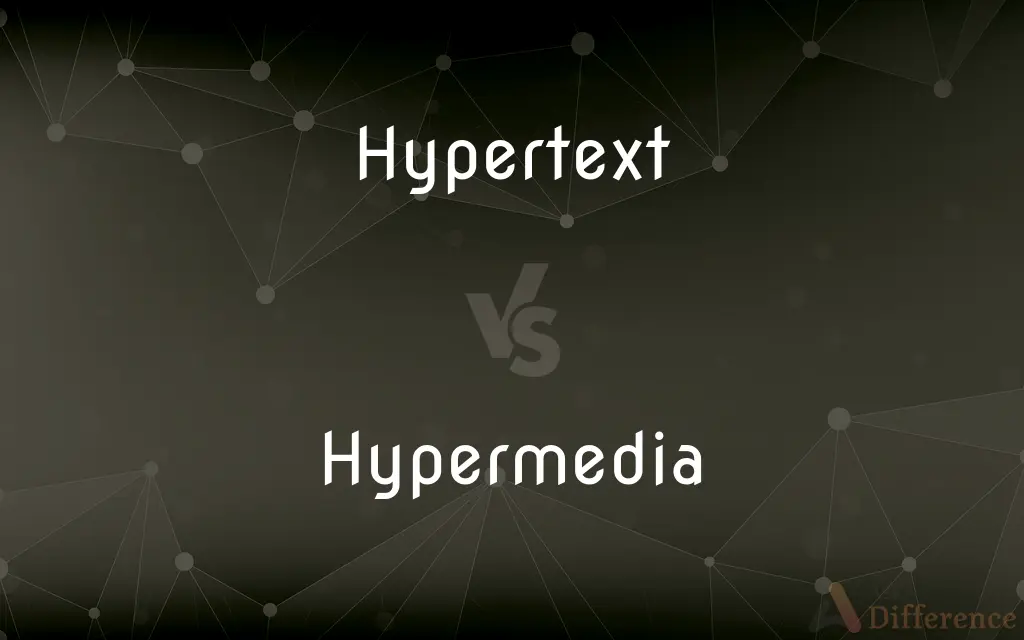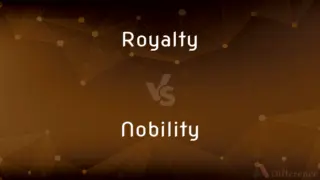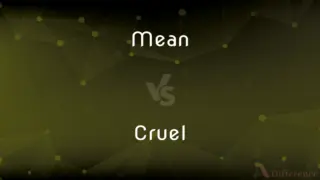Hypertext vs. Hypermedia — What's the Difference?
By Tayyaba Rehman & Maham Liaqat — Updated on March 20, 2024
Hypertext involves text with links to other texts, while hypermedia extends to linking text with various media forms (images, videos, sound). Hypertext focuses on textual connectivity; hypermedia encompasses multimedia interconnectivity.

Difference Between Hypertext and Hypermedia
Table of Contents
ADVERTISEMENT
Key Differences
Hypertext is a system that allows documents to be connected through links, enabling users to navigate from one text document to another easily. Whereas hypermedia, an extension of hypertext, incorporates not just text but also other media types such as images, audio, and video. This integration allows for a more dynamic and immersive experience, as users can navigate between diverse content formats beyond textual information.
The concept of hypertext is foundational to the structure of the World Wide Web, where web pages are interlinked through hyperlinks, forming an extensive network of textual content. This system revolutionized information retrieval, making it possible to jump from one document to another with a simple click. On the other hand, hypermedia expands this concept to the web, allowing not only textual links but also connections through multimedia elements. Websites that utilize hypermedia can offer users a richer and more engaging way to explore content, incorporating visuals, sounds, and interactive features.
In educational and research contexts, hypertext provides a valuable tool for referencing and exploring related academic papers, legal documents, and other text-based resources. It simplifies the process of finding and connecting related works, enhancing scholarly communication. Hypermedia, however, offers broader applications in these fields by supporting diverse learning styles and research methodologies. Educational content can include interactive simulations, instructional videos, and audio explanations, making learning more accessible and engaging for a wider audience.
Hypertext systems are often simpler in design and functionality, focusing on the organization and retrieval of textual information. This simplicity can make hypertext systems easier to create and maintain, especially when dealing with large volumes of text. Hypermedia systems, due to their multimedia nature, require more complex design considerations, including the integration of various media formats and ensuring seamless navigation among them, which can be more challenging and resource-intensive to develop.
While hypertext has profoundly impacted how we access and link textual information, hypermedia takes the concept further by offering a multidimensional approach to information access and exploration. Hypermedia's ability to blend text with other media types creates a more versatile and engaging digital environment, catering to the evolving expectations of users in a multimedia-rich online world.
ADVERTISEMENT
Comparison Chart
Content Type
Text
Text, images, audio, video
Interactivity
Links between text documents
Links among various media types
Use Case
Text-based websites, e-books
Multimedia websites, educational software
Complexity
Relatively simple
More complex
User Experience
Textual navigation
Multimedia interaction
Development
Easier to design and maintain
Requires integration of multiple media types
Accessibility
High for textual information
High across diverse content formats
Compare with Definitions
Hypertext
The foundation of web navigation.
Using hypertext, users can easily browse through related articles online.
Hypermedia
Integration of text with multimedia elements.
Educational websites use hypermedia for interactive learning modules.
Hypertext
Enables non-linear reading paths.
Hypertext in eBooks lets readers jump to footnotes or related chapters.
Hypermedia
Offers dynamic content navigation.
Hypermedia allows users to explore content through various interconnected media formats.
Hypertext
A digital document system linking text to other texts.
Clicking a link in a Wikipedia article takes you to a related topic.
Hypermedia
Facilitates immersive experiences.
Hypermedia is used in interactive storytelling, combining text with visual and audio elements.
Hypertext
Text-centric interconnectivity.
Hypertext allows the linking of research papers for quick reference.
Hypermedia
Supports complex informational architectures.
A museum's virtual tour might use hypermedia to link exhibit descriptions with images and audio guides.
Hypertext
Simplifies information retrieval.
Hypertext links in an online dictionary direct users to related words.
Hypermedia
Enhances user engagement through diverse media.
Hypermedia presentations can include videos, sound clips, and animations.
Hypertext
Hypertext is text displayed on a computer display or other electronic devices with references (hyperlinks) to other text that the reader can immediately access. Hypertext documents are interconnected by hyperlinks, which are typically activated by a mouse click, keypress set, or screen touch.
Hypermedia
Hypermedia, an extension of the term hypertext, is a nonlinear medium of information that includes graphics, audio, video, plain text and hyperlinks. This designation contrasts with the broader term multimedia, which may include non-interactive linear presentations as well as hypermedia.
Hypertext
Digital text that contains hyperlinks to other texts.
Hypermedia
A collection of files existing in various digital media, such as text, graphic images, and audio and video recordings, that are connected together by hyperlinks.
Hypertext
(uncountable) Digital text in which the reader may navigate related information through embedded hyperlinks.
Hypermedia
(computing) The use of text, data, graphics, audio and video as elements of an extended hypertext system in which all elements are linked so that the user can move among them at will.
Hypertext
(countable) A hypertext document.
Hypermedia
A multimedia system in which related items of information are connected and can be presented together
Hypertext
Machine-readable text that is not sequential but is organized so that related items of information are connected;
Let me introduce the word hypertext to mean a body of written or pictorial material interconnected in such a complex way that it could not conveniently be presented or represented on paper
Common Curiosities
What are common uses of hypertext?
Hypertext is widely used for web navigation, online documentation, and e-books.
What is hypertext?
Hypertext is a system that links text documents to each other, allowing for easy navigation between related content.
What is hypermedia?
Hypermedia extends hypertext by incorporating and linking multiple forms of media such as text, images, audio, and video.
What are common uses of hypermedia?
Hypermedia is used in multimedia websites, educational software, and interactive entertainment.
Is hypermedia more complex than hypertext?
Yes, hypermedia systems are more complex due to the integration of various media types and the need for more sophisticated navigation and interaction mechanisms.
Can hypertext include images?
Hypertext primarily links text documents, but it can include images as part of the text content, without the interactive or multimedia capabilities of hypermedia.
How does hypermedia enhance user experience?
Hypermedia enhances user experience by providing dynamic and interactive content that engages users through various senses.
How do hypertext and hypermedia differ?
Hypertext focuses on linking textual content, while hypermedia involves linking various types of media for a more immersive experience.
How does hypertext benefit education?
Hypertext aids education by simplifying access to related texts and resources, facilitating research, and encouraging exploratory learning.
Can hypermedia exist without hypertext?
No, hypermedia is an extension of hypertext and relies on the foundational concept of linking digital content, including text.
How does hypermedia benefit education?
Hypermedia supports diverse learning styles through interactive and multimedia content, making learning more engaging and comprehensive.
Why is hypertext important for the internet?
Hypertext is the foundation of the World Wide Web, enabling the interconnected structure of web pages and online documents.
Can hypertext exist without hypermedia?
Yes, hypertext can exist independently as it predates hypermedia and focuses solely on linking textual content.
Are hypermedia applications harder to create than hypertext applications?
Yes, due to their complexity and the need to integrate multiple media types, hypermedia applications require more resources and expertise to develop.
How do hypertext and hypermedia influence web design?
They influence web design by dictating how content is structured, linked, and presented, affecting navigation, layout, and the overall user experience.
Share Your Discovery

Previous Comparison
Royalty vs. Nobility
Next Comparison
Mean vs. CruelAuthor Spotlight
Written by
Tayyaba RehmanTayyaba Rehman is a distinguished writer, currently serving as a primary contributor to askdifference.com. As a researcher in semantics and etymology, Tayyaba's passion for the complexity of languages and their distinctions has found a perfect home on the platform. Tayyaba delves into the intricacies of language, distinguishing between commonly confused words and phrases, thereby providing clarity for readers worldwide.
Co-written by
Maham Liaqat













































